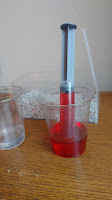Frannie's friends at the Groundwater Foundation recently published the second edition of the Training About Protecting the Source (TAPS) Manual. The manual guides users through hands-on activities that explore potential threats to groundwater and challenges them to think about what can be done to protect this key drinking water source.
Hydraulic fracturing, commonly referred to as “fracking”, breaks up the ground deep beneath the surface in order to allow companies to more easily access oil and gas. The technique uses a mixture, or slurry, of water, chemicals, and sand and pumps it into the ground at a very high pressure. Fracking fluids can contain a variety of toxic chemicals such as diesel fuel, acids, and acetone. Grouting is the process of filling the spaces between the borehole, or the hole drilled during construction, and the well casing with an impermeable material like cement. Proper grouting and proper disposal of the fracking fluids can prevent these chemicals from leaching into the groundwater.
- Awesome Aquifer Kit
- Plastic box
- Gravel
- Plastic tube
- Hand pump or syringe
- Nylon
- Rubber band
- Plastic bendable straw
- Prepare the straw by trimming the longer end so that it's approximately 3 inches long. Poke several holes along the longer side with a pushpin to represent where the fracking fluid is expelled to release the natural gas.
- A small cup (approximately 30 ml) of intensely colored water
- 16 oz cup of water
1. Read through all the instructions first before you begin to build the model. Make sure you have all the needed materials and supplies.
2. Fill the plastic box with gravel until it is about ¼ full.
3. Add water so that half of the rocks are covered. (This will represent an aquifer.)
4. Create a hydraulic fracturing injection well by securely attaching the straw to the plastic tube with a rubber band. Secure the well screen (piece of nylon) to the end of the straw with an additional piece of rubber band. You may have to cut a small slit at the short end of the straw in order to get it to roll in on itself and slide into the tubing.
5. Place your hydraulic fracturing injection well on top of the gravel. Add more gravel until the box is about ½ full.
Frannie noticed that the toxic fracking fluid was escaping out of the poorly sealed section between the well casing and the injection casing. Proper grouting could have contained the chemicals better, allowing it to be pumped out with the rest of the fluid once the hard rock layer had been sufficiently broken up. If she had properly sealed and grouted her well with cement or bentonite clay, which could be represented by the modeling clay included in the Awesome Aquifer Kit, she could have prevented this dangerous contamination.






No comments:
Post a Comment